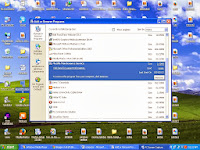Disks and Drivers
A computer user disk drives to store
information. Floppy disk drives, hard disk drives and CD-ROM drives are thew
types of drives used to store information. Each idsk drive is identified by a
name, which is called the drive name. a drive name can be any letter of the
alphabet. The floppy disk drive is usually referred to as drive A.
You can compare a hard disk drive
with that of a storage home. In a storage house, you can find partitions for
storing different types of goods. The partition will be labeled according to
the type of goods being stored in them. Similary, a hard disk drive can be
divided into a number of separate sections, where each section acts like
separate disk drive. This process of dividing the physical hard disk driveinot
various logical sections for organization is called partitioning. Each section
of the hard disk drive is called a partition.
Organizing Data
Consider this scenation. As a
teacher, you handle subjects for different. If you were to write down the notes
for all classes in the same notebook, it might be difficult to find class
specific note when you needed the .you might have to search page by page to
find the information you were looking for.
Similarly, if all the information on
a computer were stored together, it would be difficult to find it every time
you needed information. Hence, computers store data and information as
files.files are computerized documents that store information in different
forms, such as text andpictures. The bitmap images you created in paint and the
presentations you created in powerpoint are examples of files. Each file stored
on a computer has a name to identify it. This is called the file name. All
files have two parts in their names: the primary name and the extension.
Primary name
This is the first part of the file name. it is
the anme by which a file is identified.
Extension
The second part contains
the extension of the file name. the identifies the type or family of the file.
An example of a file
anme created in word is Lesson1.doc. Here, lesson1 is the primary name of the
file and .doc is the extension, an example of a filename in paint is
picture.bmp. Here, picture is the primary name and .bmp is the extension.
A file name can contain;
· Letters
· Numbers
· Spaces
· Special
characters, such as the following:{ } [ ] , . ! $ % @.
Though you can use any
name for your file, it is always a good practice to give meaningful anmes to
your files. By just referring to a file name, you should be adle to know what is
stored in the file.
Suppose you maintain the
marks, attendance details and notes for each of your classes in separate files
. If these files are scattered throughout various places, the the files may be
difficult to locate. However, if the
files were stored in a common, organized location, hey would be easier to
locate and mainitain. To organize files, windown XP provides the concept of
folders. A folder acts as a storage comtainer for files. You can use a folder
to stored files about a particul ar topic together in
Common location. A
folder icon is yellow in color.
Imagine a library in
which books on various subjects are shelved together. In such a situtino,
searching for a book would be a difficult task . however, if the book for each
subject were arranged on separate sheves, it would be easier to find a book.
Similarly, if all the files on computer are stored are stored together without
organization, they become difficult to locate. It is important to organize the
file in folders.













































